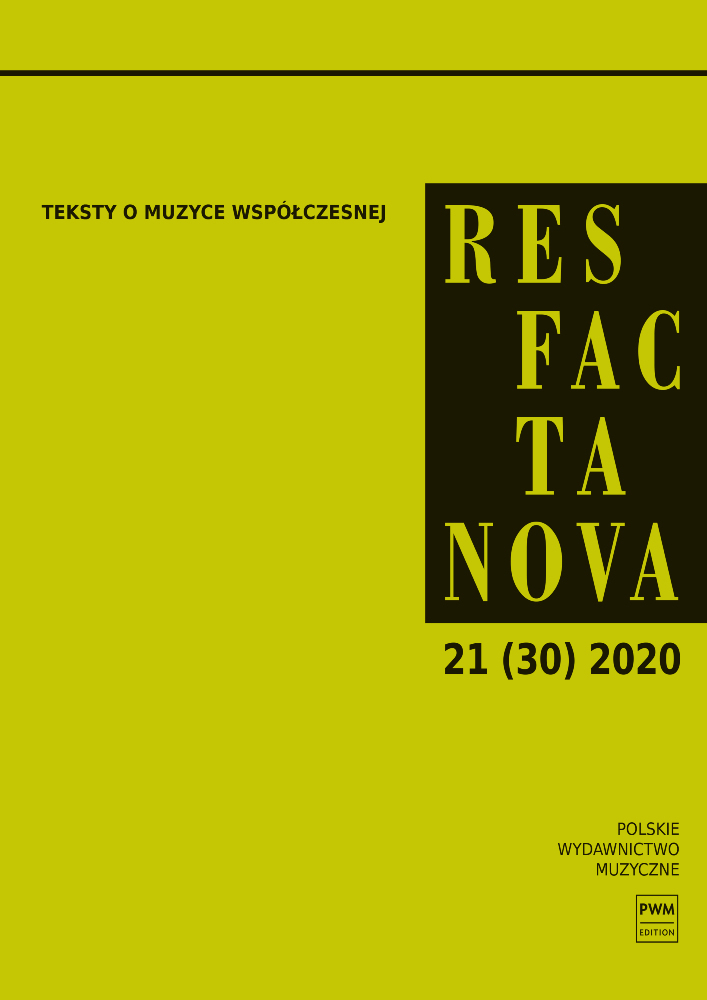Abstract
The aim of the paper is to reconsider the question of usefulness of the category of isotopy in semiotic analysis of a musical composition, on the example of Zygmunt Krauze’s Arabesque (1983) for prepared piano and instrumental ensemble. Adopting a suggestion by Nicolas Meeùs, the author undertakes an attempt to transpose Rastier’s differentiation between semantic isotopy and isotopy of the plane of expression (isotopie de l’expression) into analysis of music. Following Michel Arrivé, she presents a model example of isotopic relations in the plane of expression (signifiant) from the novel Les jours et les nuits (Days and Nights) by Alfred Jarry, and finds that isotopy of the plane of expression is for linguistic semioticians an alternative to semantic isotopy in providing cohesiveness in the layer of signs that construct meaning. She then discusses the extent of application of isotopy in music semiotics and draws attention to the semantic capacity of this category in Eero Tarasti’s theory and interpretive practice, where it undergoes metaphorisation and a kind of universalisation. She also refers to the proposal of Jean-Pierre Bartoli to use isotopy in analysing Orientalistic exoticism, which constitutes an example of a return to the level of the simplest constitutive units and the condition of their iteration, i.e., to the structuralistic-semiotic conceptions of isotopy in the approach of Greimas. Moving on to an analysis of Krauze’s composition, the author puts forward the view that Rastier’s categories of isotopy of the plane of expression as „conditions of grammaticality” (conditions de grammaticalité) of an utterance can only apply to specific cases of compositional techniques which are utterances in systemic „musical languages”, and this condition is not met in the case of the work analysed. The argumentation presented in the article is based on an analysis of particular features of the organisation of the sound material, the texture and syntax of Arabesque, as well as references to the composer’s claim to have been inspired by the mystical paintings of Władysław Strzemiński and the oriental connotations of arabesqueness in music. In seeking the musical meaning of Krauze’s Arabesque the author focuses on identifying its intentio operis.
References
Arrivé Michel, Pour une théorie des textes poly-isotopiques, „Langages” 1973 t. 8 nr 31 (Sémiotiques textuelles), s. 53–63.
Bartoli Jean-Pierre, Esquisse d’une chronologie des figures rhétoriques de l’exotisme orientaliste français au XIXe siècle, [w:] La musique entre France et Espagne: Interactions stylistiques 1870–1939, red. Louis Jambou, Presse de l’Université de Paris-Sorbonne, Paris 2004, s. 201–213.
Bartoli Jean-Pierre, Propositions pour une définition de l’exotisme musical et pour une application en musique de la notion d’isotopie sémantique, „Musurgia” 2000 t. 7 nr 2, s. 61–72.
Desquilbe Fabienne, Les techniques de la narration aux origines de l’opéra: isotopies et strategies narratives dans l’Orfeo de Claudio Monteverdi. Projet d’une approche interdisciplinaire de la naissance de l’opéra en Italie, [w:] Musical Semiotics in Growth, red. Eero Tarasti, Paul Forsell, Richard Littlefield, Indiana University Press, Bloomington 1986, s. 437–450.
Eco Umberto, Dzieło otwarte. Forma i nieokreśloność w poetykach współczesnych, przeł. Jadwiga Gałuszka [i in.], Czytelnik, Warszawa 1973.
Eco Umberto, Lector in fabula. Współdziałanie w interpretacji tekstów narracyjnych, przeł. Piotr Salwa, PIW, Warszawa 1994.
Eggebrecht Hans Heinrich, Uwagi o metodzie analizy muzycznej, przeł. Maria Stanilewicz, „Res Facta” 1973 t. 7, s. 45.
Greimas Algirdas J., Du sens. Essais sémiotiques, Seuil, Paris 1970.
Greimas Algirdas J., Les relations entre la linguistique structurale et la poétique, „La Revue internationale des sciences sociales” 1967 t. 19 nr 1, s. 8–17.
Greimas Algirdas J., Sémantique structurale: recherche et méthode, Larousse, Paris 1966.
Jabłoński Maciej, Muzyka jako znak. Wokół semiotyki muzyki Eero Tarastiego, Wydawnictwo PTPN, Poznań 1999.
Kerbrat-Orecchioni Catherine, Problématique de l’isotopie, „Linguistique et Semiologie” 1976 t. 1, s. 11–33.
Rastier François, Systématique des isotopies, [w:] Essais de sémiotique poétique, red. Algirdas J. Greimas et al., Larousse, Paris 1972, s. 80–115.
Strzelecki Paweł, Krauze Zygmunt, [hasło w:] Kompozytorzy polscy 1918–2000. II. Biogramy, red. Marek Podhajski, Wydawnictwo Akademii Muzycznej im. Stanisława Moniuszki, Gdańsk–Warszawa 2005, s. 463–467.
Szerszenowicz Jacek, Unizm i sensualizm w muzyce Zygmunta Krauze, [w:] Zygmunt Krauze. Unizm i sensualizm /Unism and sensualism, red. Jacek Szerszenowicz, Akademia Muzyczna im. Grażyny i Kiejstuta Bacewiczów, Łódź 2015, s. 58–65.

